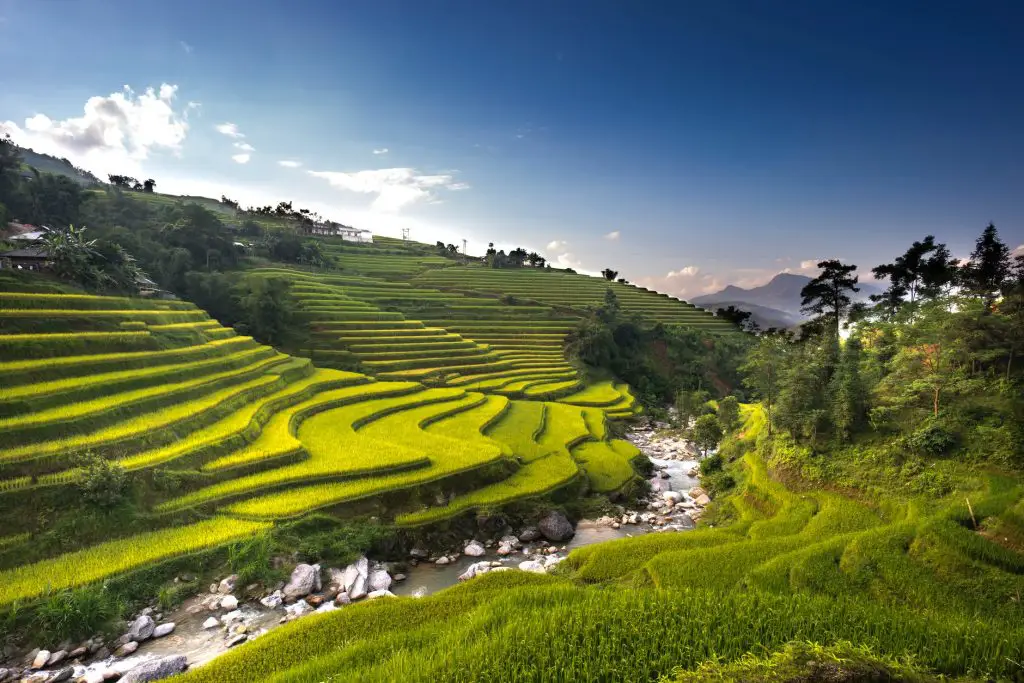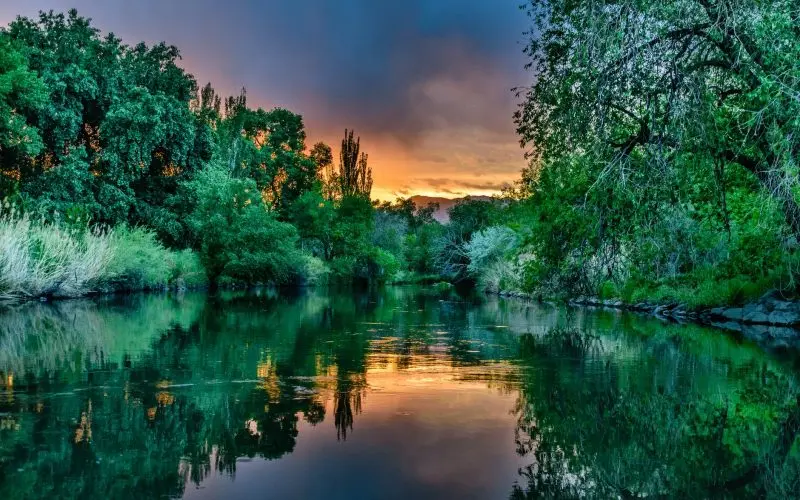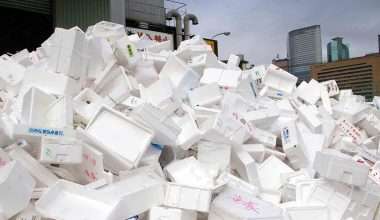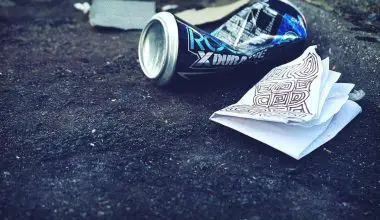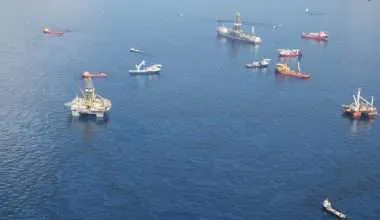Table of Contents Show
Table of Contents
- What is Erosion?
- What is Soil Erosion? (Types)
- Few Causes of Soil Erosion:
- Few Effects of Soil Erosion:
- 11 Ways to
Prevent and Control Soil Erosion
- 1. Planting Permanent Vegetation
- 2. Riprap, stabilizing soil with stones and boulders
- 3. Terracing
- 4. Mulching
- 5. Use of Cover Crops
- 6. Control Blankets and Fiber Rolls (Temporary)
- 7. No-till farming and gardening methods to reduce soil erosion
- 8. Prevention of soil erosion caused by livestock
- 9. Afforestation to Preserve Soil
- 10. Control of water flow
- 11. Contour farming
What is Erosion?
Erosion is a naturally-occurring process that will always occur but we are a wide contributor to increasing the rate of this process throughout the planet which has led to the ever-increasing problem of soil erosion.
No continent or planet is immune to the phenomenon that is soil erosion, which is steadily increasing its effect over the past few decades.
What is Soil Erosion? (Types)
Soil erosion is the erosion of the topmost highly fertile layer of soil consisting of most nutrients and minerals. Soil erosion can happen through multiple ways including wind and water. When wind carries off the topsoil, it is called wind erosion. Whereas, when flowing water carries away the topsoil, then it is known as water erosion.
Few Causes of Soil Erosion:
Soil erosion occurs through various human activities such as the removal of forests, it has been stated that clearing of forests to make way for construction and agricultural land has led to an incredible loss of soil up to 52 percent.
Every year approximately 10 million hectares of arable land are abandoned due to soil erosion.
Such a high rate of loss of soil makes agricultural field infertile, requiring constant use of synthetic chemicals and fertilizers which themselves possess potential downsides and even the complete abandonment of lands as stated previously.
Few Effects of Soil Erosion:
Soil erosion can lead to other issues such as the increased risk of landslides and flooding as there is no soil available to prevent this.
If this keeps ongoing there will soon be a lack of food shortage as there won’t be enough fertile soil available to produce good yield crops for the demanding populations, leading to global famines.
You should remember that the soil is host to various species living and depending on it for nutrition and living. If the soil was to be eroded, we may lose a vast amount of species and destroy the biodiversity of that ecosystem.
As soil erosion is such a massive issue, we have mentioned some methods which have been scientifically proven and tested to reduce the amount of soil erosion occurring in the first place.
These measures can be applied in small yards or on large hectares of land to control the spread of soil erosion.
11 Ways to Prevent and Control Soil Erosion
Soil erosion, if left to progress, it can go beyond control and cause irreversible consequences regardless of the size or terrain of the land.
Even If the land can be fixed, it would require a massive amount of money and resources to bring it back.
Hence, it is better to control and prevent soil erosion before it becomes way beyond our control. It is in the best interest of us that we should control soil erosion before it’s too late. This is not just to protect our land for future generations, but also to protect the species living in the soil.
Here are some methods that can help control the soil erosion occurring on land.
1. Planting Permanent Vegetation
This is a very effective method in areas which are highly prone to soil erosion such as streams, hillsides, and rivers. This process involves the planting of vegetation which has very deep roots so that the soil can be held in place.
Plants most commonly used for this method are purple needle-grass, wildflowers, native prairie grasses, and woody perennials.

You must select the plant that you need for your land according to the specific conditions of your land.
If your land is located in a dry area that is commonly associated with drought, use species that are drought resistant.
If you want to reduce the surface runoff and water accumulation, use trees, and grasses which are excellent for wet conditions as they will absorb all the moisture from the surface and release it from their aerial parts in the form of water vapor (transpiration), in-turn reducing the water-logging of soil.
Willows are a very good species of trees that can be used for building strong underground root networks in the soil. These trees can withstand soil with high salt concentrations and grow well in humid conditions.
These trees can perform various functions which can lead to the development of a healthy environment if planted accordingly.
You can even plant stripes of permanent land cover with native grasses and tree barriers which can also prevent erosion. Nice diverse landscapes can be created which prevent soil erosion and yield good crops and also give aesthetics to your land.
2. Riprap, stabilizing soil with stones and boulders
This solution is most commonly employed in areas where the soil is constantly eroded by water. Riprap comprises the placement of large rocks on some step slopes or areas where there is strong water runoff.
This helps to stabilize the soil and to cover its surface and also decreases the speed of water runoff, thereby reducing the adverse effects on exposed soil downstream. These large rocks have a proven track record when it comes to stabilizing storm drainage ways.
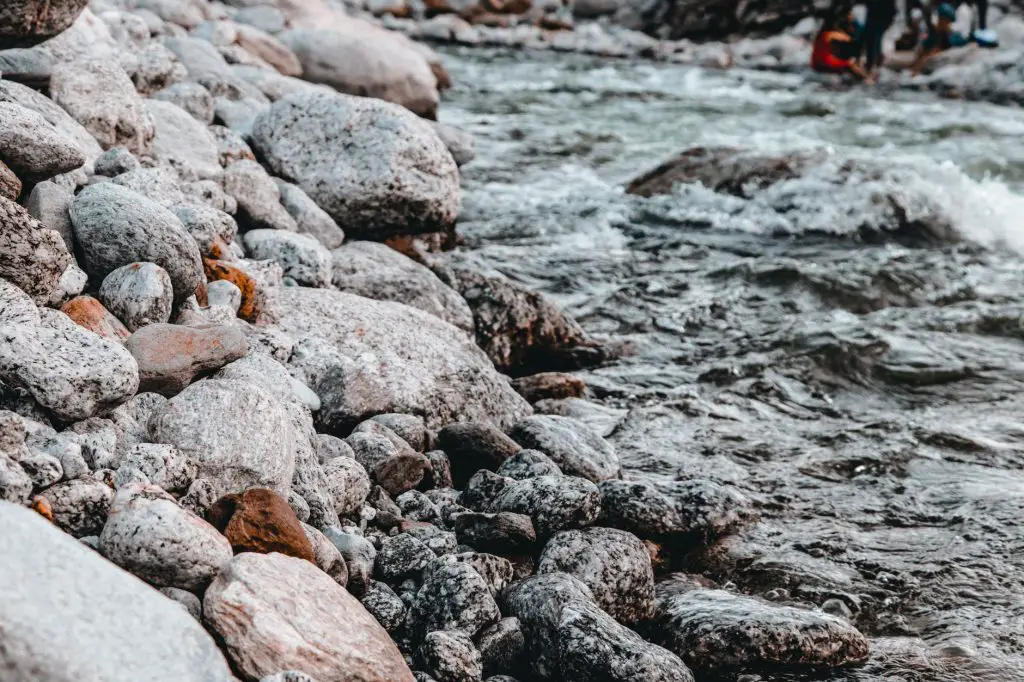
The ripraps are a very durable solution when it comes to controlling soil erosion. Rocks don’t require any long-term maintenance, they just need to be of the proper size and be placed correctly and they can prove to be a long-term solution for soil erosion.
However, it is very important when it comes to ripraps that the size of the rocks is selected properly and the slopes in which they are installed are not very steep.
If the slopes selected are steeper, they may lead to displacement of the rock which can cause damage to infrastructure below and ultimately defeats the purpose of controlling soil erosion.
3. Terracing
Terracing has been used for almost 5,000 years to cultivate crops in hilly areas. Terracing has been done in areas that are easily susceptible to erosion.
This method is better than farming on sloped areas as slopes have very high chances of loss of water and nutrients via runoff.
Hence, the slopes are converted into terraces by breaking them down into flatlands on which crop cultivation can be carried out.
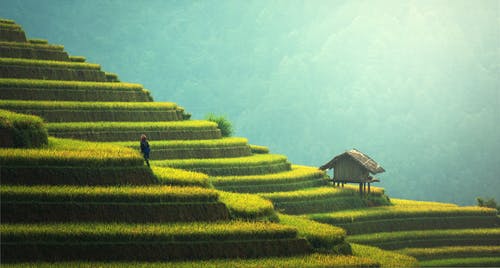
Walls are constructed along the terrace. The purpose of building walls is to hold the soil in place. The walls also help to prevent the runoff of water, helping in water retention and infiltration into the soil.
It prevents carrying of sediments down the terrace after seasonal rain and also helps in better drainage of water from the land.
Terracing allows cultivation of lands which may be impossible for practicing agriculture otherwise. They also give good aesthetic character to your lands which can be converted into garden beds that are easy to maintain.
Some slopes which aren’t as steep so don’t require use of walls as simple ‘edging’ with small stones and bricks could prevent erosion.
Sometimes creating an ‘edge’ using such materials is necessary and one can easily make borders of compacted soil (using a spade) to prevent soil erosion downhill.
4. Mulching
Mulching doesn’t even require the planting of crops on your land. All it requires is the use of mulching material which, after applying, prevents the washing and erosion of the soil without the soil losing its moisture in the process.
Mulching stabilizes the temperature of the soil, thereby ensuring the protection of the soil and crops from the effects of fluctuating temperature conditions.
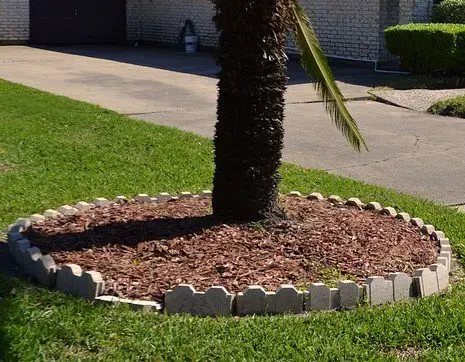
Commonly used mulching materials include wood chips or bark. These are used as they provide a nice, clean look to the land. Organic mulches are used if you want to provide your soil with organic material during the spring and fall season as organic mulches are known to decompose faster.
Mulches can be used on slopes; however, it is advised not to use mulches on steeper slopes as they may be carried down by water runoff.
5. Use of Cover Crops
Cover crops as the name suggests, are used for covering the soil in between plantations and serve the same function as the planting of permanent vegetation. They protect the soil from all types of weather conditions including high-speed winds, rainfall, and water runoff. Cover crops include rye, lentil, mustard, clover, and barley.
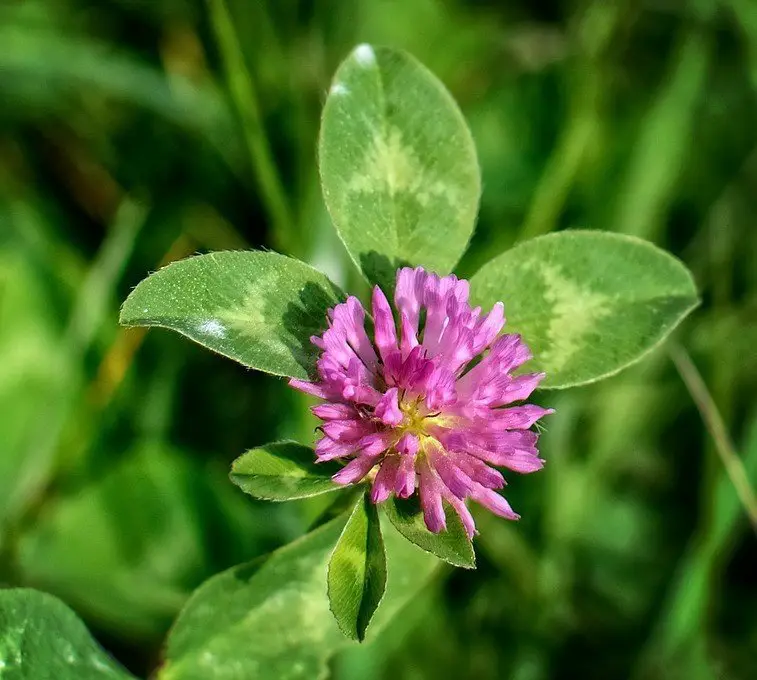
The use of cover crops should be done after harvesting your main crops because they provide the necessary rest your land needs before taking up another energy-intensive crop.
Planting of cover crops is advised after the harvesting of crops is completed because the land’s soil will remain barren and unprotected which will make the soil exposed to damage and erosion. Studies indicate that cover crops can reduce soil loss by 30 to 100 percent when compared to fields without cover crops.
Cover crops also help the infiltration of water into the soil and also enrich it with nitrogen. The cover crops prevent the growth of weed after the harvesting of the main crops is done.
6. Control Blankets and Fiber Rolls (Temporary)
Control blankets and Fiber rolls are the best solution for controlling erosion on steep hills. They prevent erosion on slopes that become barren during landscape rehabilitation or during construction activities as they slow down surface water flow.
Control blankets are also deemed efficient in controlling erosion on steeper slopes. These preventative agents are built with natural and synthetic materials that may be bonded together.
Erosion control blankets are manufactured from various biodegradable materials that do not provide harm to wildlife and also serve the purpose of allowing the growth of vegetation and water infiltration. The fact that they are made from biodegradable materials means that they are a temporary solution.
However, biodegradable control blankets are used in such a way that they can stabilize the soil before permanent vegetation takes the responsibility to substitute its function.
For long term solutions, synthetic blankets, as previously mentioned, are also available which can provide support for more than 3 years.
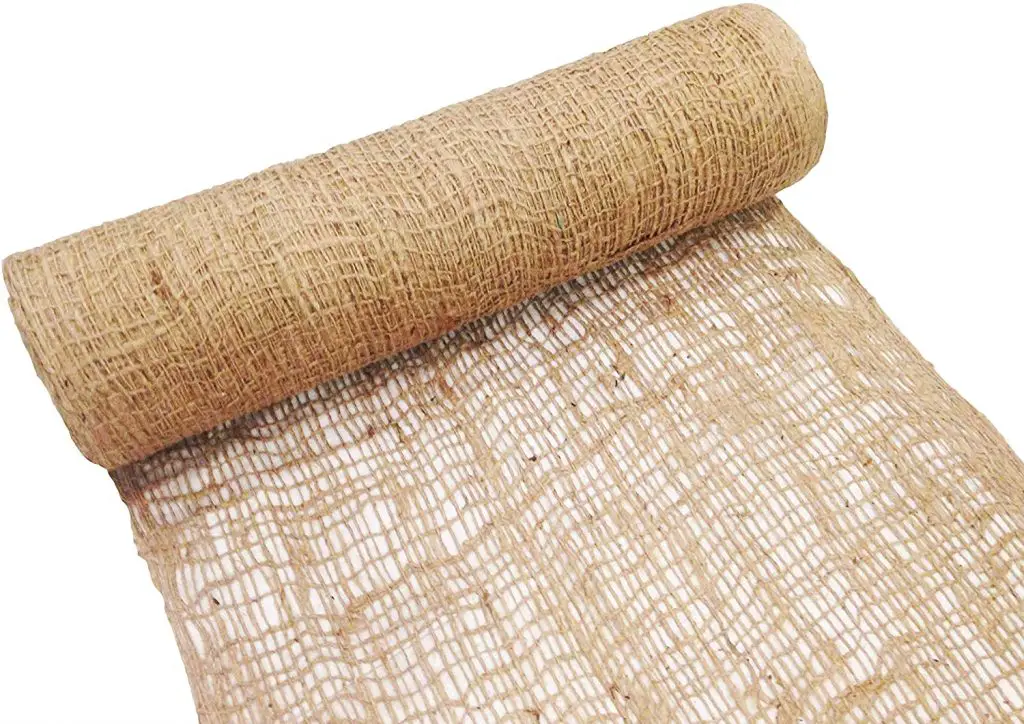
Fiber rolls are also considered as a temporary erosion control measure. They also serve the function to slow down water movement downhill by creating horizontal barriers along slopes.
They also trap excessive sediments.
This helps to create favorable conditions for vegetation and once permanent vegetation is successfully grown, these barriers can then be removed. Fiber rolls are made from coconut fibers, straw, rice, and wattle.
7. No-till farming and gardening methods to reduce soil erosion
Using no-till farming method can preserve the structure of the soil. Additionally, erosion is significantly reduced as compared to tillage cultivation.
When soils are tilled (manually overturned), the healthy soil structure is significantly harmed as crop residues and vegetation are removed from the soil surface leaving the particles of soil exposed to rain and wind.
The porosity of soil is lost when the soil is disturbed, preventing proper water infiltration and increasing water runoff that further encourages erosion.
Just for your information, Tilling is manually overturning the superficial layer of soil with different methods like raking, shoveling or picking.
If the soil is left undisturbed, the biological activity within the soil will flourish and the soil structure will remain protected as it will not be disturbed due to tilling.
This will enhance the nutrient cycle and improve the overall health of the soil. This will ultimately lead to better water infiltration into the soil, reduction in water runoff and the ability of the soil to withstand adverse weather conditions.
8. Prevention of soil erosion caused by livestock
Overgrazing by high livestock populations placed in a small area is one of the most common causes of not just soil erosion, but also of land degradation.
Unsustainable livestock management can lead to overgrazing and a decrease in ground cover. Massive amount of vegetation gets eaten and lost which accelerates the rate of soil erosion.
The soil may also become compacted, which further limits the ability of vegetation emerging in that area. All these factors ultimately contribute largely to soil erosion by wind and rain.
Vegetation should be given adequate time to recover and the natural capacity of the land should be given the right respect, and according to that land capacity, the amount of livestock should be kept.
Sustainable grazing methods and management techniques allow adequate time for vegetation to grow and ample rest for soil preventing soil erosion from occurring.
9. Afforestation to Preserve Soil
Planting trees is very beneficial when it comes to preserving the soil and hence afforestation is considered a long term effective solution for controlling soil erosion.
They prevent the runoff of nutrients and topsoil by water along as well as build a strong root system underground which provides adequate retention of the soil.
Read more; Major Causes and Effects of Afforestation
Trees have an incredible water-holding capacity, thus providing an effective and cheap method when it comes to dealing with the problem of water-logging (kinda like soil drowning in water).
Fallen dead leaves of trees act as natural mulch as they have a great capacity of absorbing water. Trees are highly effective in creating a stable soil and ecosystem which also helps in balancing the water cycle of that habitat.
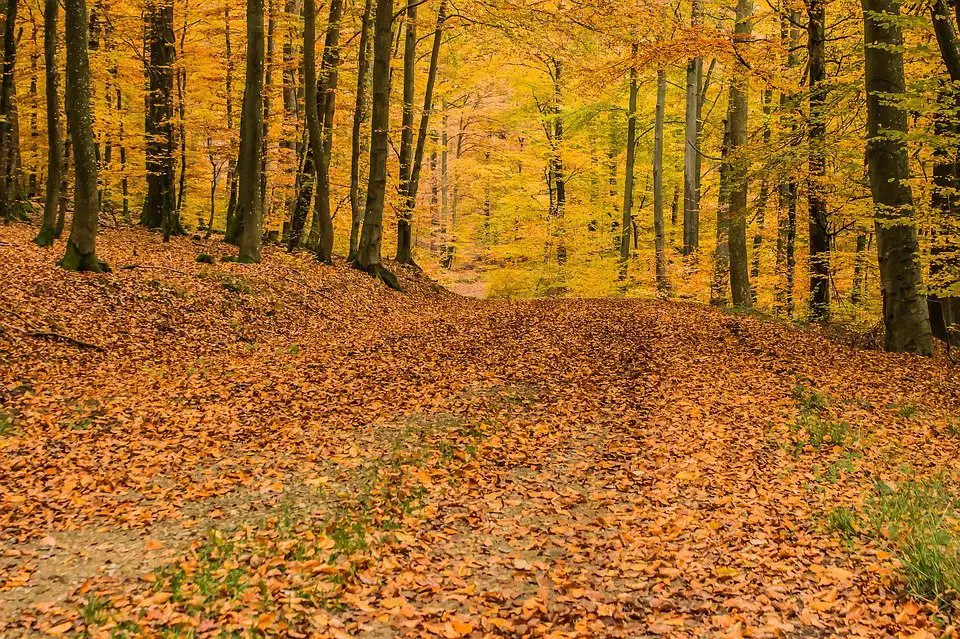
10. Control of water flow
If you are constantly dealing with the problem of soil erosion, you can adopt various measures controlling the flow of water through your land.
Creeks can be built which can divert water away from your lands. You can also build or install drainage pipes that get rid of water from low-lying parts of your land.
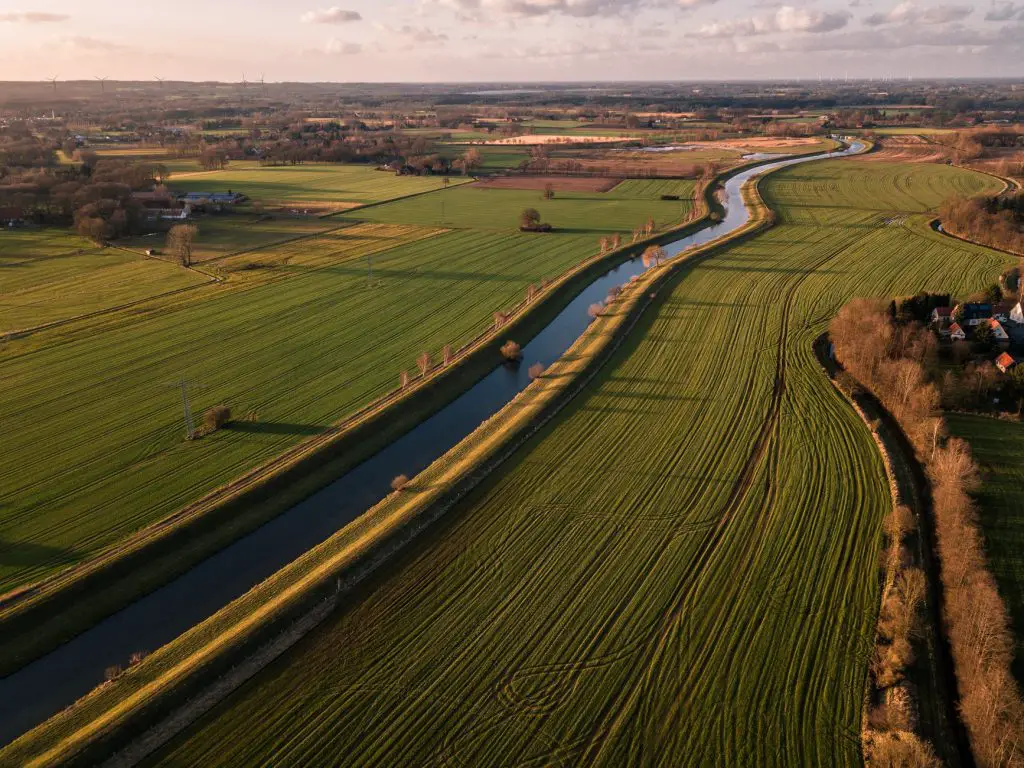
You can also construct berm (border of compacted soil) if you are facing strong water runoff in your area from places that are hilly or have very steep slopes.
Berm is an artificially created hill of compacted soil, which basically borders your ground and ultimately changes the course of water runoff.
Farmers can make retention ponds for rainwater harvesting or imitating natural wetland habitats where water tends to accumulate frequently.
This measure is very useful in controlling erosion if your land has a spot like that available, as you will have the ability to direct the flow of water from one place to another and prevent it from running off. This is very useful for farmers in drought conditions or when water is very limited and the crop constantly requires irrigation.
Farmers practicing agriculture in hilly areas tend to build trenches and swales to accumulate runoff water. This allows water to be stored so that it can be infiltrated into the soil (and subsequently the crops) over an extended period of time.
Just make sure to cover the surface of water so that it doesn’t become a breeding ground for pests, mosquitos and whatnot.
11. Contour farming
Contour farming is a method employed in areas consisting of slopes on which crop growing and cultivation is very difficult and soil erosion is very common.
In contour farming, the farmer plants and plows across a slope along the contour lines as compared to planting and plowing downhill. Following natural contour lines reduces soil erosion by 50 percent.
The loss of nutrients is greatly reduced, and contour cropping gives a higher yield of crops as water retention is significantly improved.
Strip cropping is a practice that further increases the positive impact of contour farming. It is more effective in steeper slopes where the key to preventing soil erosion is water retention.
The objective of strip cropping is to plant various crops in alternative strips, to allow the nutrients to replenish the soil so it becomes healthy once again.
